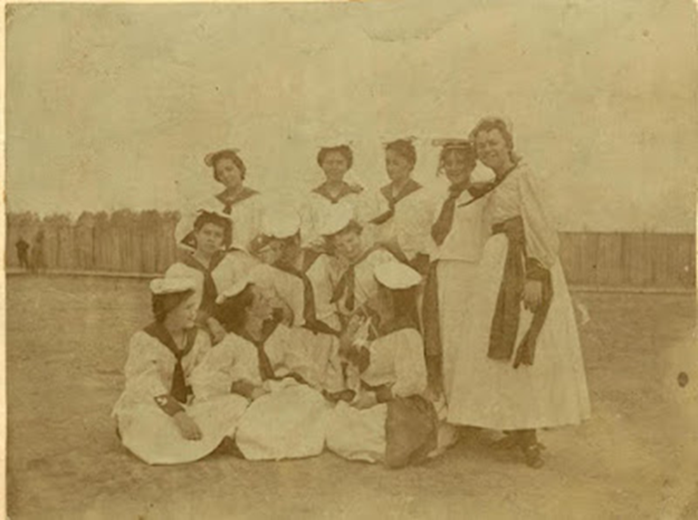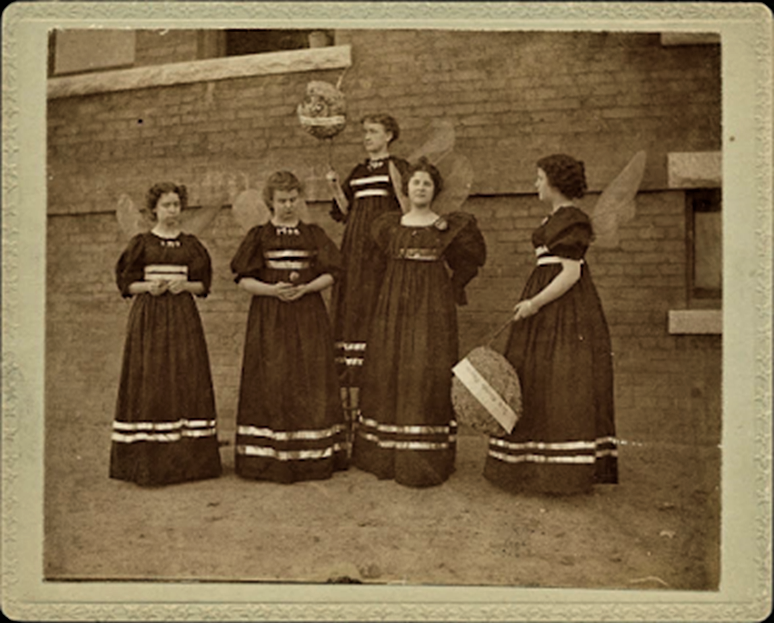by Kathelene McCarty Smith
Plays and productions were an important part of early campus life at the State Normal and Industrial School (now The University of North Carolina at Greensboro). They were not only a creative outlet for the students, but also an ideal way for classmates from across the state to get to know each other better. In addition to obvious social benefits, the earliest campus productions drew attention to the new school during a time when the North Carolina Legislature was making important appropriation decisions for the state’s colleges. Charles Duncan McIver, the founder and first president of the small state women’s college, was constantly defending his school and advocating for recognition and financial and political benefits.

In this vein, during visits of the Legislature’s Education Committee in 1894 to assess State Normal’s buildings, grounds, and administrative management, McIver planned a State County Fair, intending to show off his new school and student body from across the state. He appointed four students to plan the auspicious event, during which the Committee, local businessmen, and the general public were entertained with a competition to present the most creative skit featuring significant local products and notable historic figures from the students’ home counties. The Fair took place in the auditorium, or “chapel,” of the Main Building (now the Foust Building), and included elaborate costumes and props, as well as cleverly titled banners. The skits varied greatly in size, depending on how many students were from a certain county. A particularly large group from Yadkin County incorporated corn shucks and a large bottle with a banner reading, “Yadkin furnishes corn in all its forms.” Particularly singled out were the “bevy of sailor girls” from New Hanover County who sang a rollicking version of “A Sailor’s Wife a Sailor’s Star Should Be.” Only one “plucky” girl represented Greene County, but she did so with great flair, wearing a garland of corn and holding a squealing piglet on her back. It’s hard to believe that the piglet, as well as her banner reading “hog and hominy,” did not push her into the winner’s circle. Yet, the victorious county was Rockingham, which represented a cradle holding a sugar-cured ham and students dressed as nurses carrying shields representing four governors from that area of the state. Their banner declared, “Nursery of Our Governors.” For winning the day, the Rockingham girls were awarded the Grand Prize of a framed picture of Pilot Mountain. The event was a notable success and hailed as “one of the most unique entertainments ever given in the state.” Afterwards, the students were feted with oysters and hot chocolate.

The County Fair program was replicated during the next Legislative Committee visit in 1897. McIver welcomed the committee at a dinner at the Benbow House Hotel in downtown Greensboro, then accompanied them back to the State Normal to see the elaborate presentation prepared for them. It began with a costumed student chorus representing the three departments of the school – Business, Domestic Science, and Pedagogy. Subsequently, there was a presentation, which featured students parading across the auditorium stage, with musical accompaniment, representing home counties. The audience was ecstatic at the portrayals, which sometimes incited humor, patriotism, and pathos. The Mecklenburg County offering, which represented students dressed as hornets, was very well received, as was the Lenoir County skit which featured students as “Cotton,” with wreathes atop their heads. As many of the students were from Guilford County, the stage was filled with girls dressed as Revolutionary soldiers sporting tricornered hats, who were soon joined by peers in dresses of white and gold, the school colors. The entire group then sang “America,” with patriotic fervor. But the high point of the pageant was a mock legislative session presented by thirty-five State Normal students dressed as senators and legislators, during which the College’s appropriation budget was increased by $100,000. The moving finale included a tableau vivant which featured students from their eighty-seven home counties gathered around the Great Seal of North Carolina singing “The Old North State.”

Yet it was not only the students who held the stage. During the 1897 Legislative visit, one member of the committee announced to the students that he believed in women’s rights and that women should have the same educational advantages as men – this was met with enthusiastic applause. He went on to praise the school by saying, “I wish to say that … after our investigation of this institution, that not before in history has there been an institution started with such a faculty, with such buildings with such a student body, with so little money.” McIver’s plan to win over the committee had been successful. The visitors had found the Fair entertaining, original, and instructive, and they returned to Raleigh pledging to support appropriations for the school.
As usually happens with large events, the 1897 State County Fair did not go without a hitch. It also stands out for being the year that students from Durham allegedly sewed cigarettes into their costumes, which they promptly smoked after the event and consequently were severely reprimanded by the faculty. Whether this is a true story or only a rumor, it remains part of the unofficial college lore.

By the time the Committee visited again in February 1899, the student productions had taken on a more political theme, most likely due to the Spanish-American War. The tableaux vivants included representations of “E Pluribus Unum – American Types,” “Way Down Yonder in Dixie,” and “Justice.” Also featured was a scene symbolizing the “School of Education,” in which Uncle Sam played by E. J. Forney, the College’s treasurer and professor of business, gave the Philippines, Hawaii, Puerto Rico, and Cuba instruction in self-government. This was a common theme after the conclusion of the Spanish-American War, and reflected political cartoons of the day, which showed Uncle Sam attempting to teach a new class of unruly American territories. The production was met with “deafening applause,” and considered a rousing success. The presentation ended once again with a tableau vivant of the Great Seal of North Carolina surrounded by representatives of all of the counties singing “The Old North State.” Although these early State County Fairs were obvious attempts by President McIver to sway the State Legislature, the tradition of the County Fair Day holiday on campus, which included exhibits and rides, would continue until 1920 when it was finally abolished.
This article was originally written for the Society of North Carolina Archivists Archives Month blog, 10 October, 2022